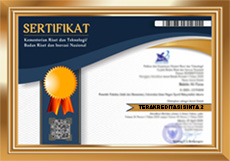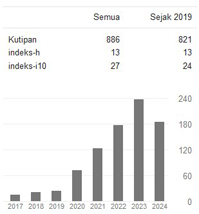KETAKUTAN 1965 SEBAGAI KETAKUTAN MASA KINI: Menelaah Ketakutan Sekuler, Agama dan Supranatural
Abstract
Keywords: Ketakutan, Katolik, komunis, Islam, hantu, sekuler, agama, supranatural.
Full Text:
PDFReferences
Anonim., Dari Madiun ke Lubang Buaja, Dari Lubang Buaja ke …?. Jakarta:Sekretariat Nasional K.M. Gunung Sahari 88, 1967.
.........(Arsip), Laporan Pertemuan Konsultasi Pastoral Nusa Tenggara. Ledalero,19-24 Oktober 1998.
Adelaar, K. Alexander and D.J. Prentice, “Malay: Its History, Role and Spread”. In Atlas of Languages of Intercultural Communication in the Pacific, Asia and the Americas. Berlin: Walter de Gruyter & Co., 1996.
Aditjondro, George Junus, Manuscript. Dated 3 February 2008 (http:// www.mail-archive.com/wanita-muslimah@yahoogroups.com/msg42559.html), 2008.
Anderson, Benedict R. and Ruth T. McVey, “A Preliminary Analysis of the October 1, 1965, Coup in Indonesia”. Interim Reports Series. Ithaca,New York: Modern Indonesia Project, Southeast Asia Program,Cornell University, 1971.
Aritonang, Jan Sihar and KarelSteenbrink. Eds., A History of Christianity in Indonesia. Leiden, The Netherlands: Koninklijke NV Brill, 2008.
Badri, Jusuf, Inilah Komunisme dan “Agama” Komunis. Jakarta: Penerbit Restu Agung, 1997.
Barnes, R.H., “Fransiskus/Usman Buang Duran; Catholic, Muslim, Communist”. In Bijdragen tot de Taal-, Land- en, Volkenkunde (159),no: 1, Leiden (2003), hlm.1-29.
Coppel, Charles A. Ed., Violent conflicts in Indonesia: analysis, representation,resolution. London, New York: Routledge, 2006.
Cribb, Robert. Ed., The Indonesian Killings 1965-1966 Studies from Java and Bali. Clayton: Centre of Southeast Asian Studies, Monash University, 1990.
Cribb, Robert and Colin Brown, Modern Indonesia: A history since 1945.London and New York, Longman, 1995.
Crouch, Harold, “Another Look at the Indonesian “Coup””. In Indonesia.Vol. 15 (Apr. 1973), hlm.1-20.
da Cunha, Ignas, Viator Parera, Hendrik Djawa and John Prior, Berpastoral di Tengah Badai: Potret Gereja Maumere 1956-1969. Ende: Arnoldus Ende, 1999.
D’Arcy, Martin C., Communism and Christianity. New York: Penguin Books,1956.
Farid, Hilmar, “Indonesia’s original sin: mass killings and capitalist expansion, 1965-66”. In Inter-Asia Cultural Studies. Volume 6,
Number 1 (2005), hlm.1-15.
Farram, Steven, “Revolution, Religion and Magic: The PKI in West Timor, 1924-1966”. In Bijdragen Tot De Taal-, Land- En Volkenkunde (BKI), Journal of the Humanities and Social Sciences of Southeast Asia and Oceania, 158.1 (Leiden, The Netherlands: Koninklijk Instituut Voor Taal-, Land-En Volkenkunde (KITLV), Royal Institute of Linguistics and Anthropology, 2002), hlm.21-48. “The PKI in West Timor and Nusa Tenggara Timur: 1965 and beyond”. In Bijdragen tot de Taal-, Land-en Volkenkunde, 166-4 (2010), hlm.381-403.
Fernandez, I.Y., “Bahasa Lamaholot Ile Mandiri”. Tesis Sarjana. Yogyakarta:Universitas Gajah Mada, 1977.
Fox, J.J. Editor, “Comment on Early Austronesian Social Organization: the Essence of Language, by R. Blust”. Current Anthropology 21 (1980).
Graham, P., “To follow the blood: the path of life in a domain of eastern Flores, Indonesia”. Ph.D. Thesis. The Australian National University,Canberra, 1991.
Heidegger, Martin, Being and Time. Trans. John Macquarrie & Edward Robinson. Oxford UK & Cambridge USA: Blackwell, 1963 [1978]. Being and Time. Trans. Joan Stambaugh. Albany: State University of New York Press, 1953 [1996].
Heryanto, Ariel, State Terrorism and Political Identity in Indonesia: Fatally Belonging. London and New York: Routledge, 2006. “Film, Teror Negara dan Luka Bangsa”. In Tempo (Edisi 1-7 Oktober 2012).
Hindley, Donald, “Indonesian Politics 1965-7: The September 30 1968.Movement and the Fall of Sukarno”. In The World Today. Vol. 24,No. 8 (aug., 1968), hlm.345-356.
Kammen, Douglas and Katharine McGregor. Eds., The contours of mass violence in Indonesia, 1965-68. Singapore: NUS Press, 2012.
Kierkegaard, Fear and Trembling, ed. by Evans, C. Stephens and Sylvia Walsh. United States of America: Cambridge University Press,2006.
Krell, David Farrell. Ed., 1993. Martin Heidegger: Basic Writings. San Francisco: Harper Collins, 1993.
Kroef, J.M. Van Der, “Origins of the 1965 Coup in Indonesia: Probabilitiesand Alternatives”. In Journal of Southeast Asian Studies. Vol.3, No. 2(Sep., 1972), hlm.277-298.
Lewis, Douglas E., People of the Source: The Social and Ceremonial Order of Tana Wai Brama on Flores. Dordrecht-Holland/Providence-U.S.A:Foris Publications, 1988.
Luhulima, James, Menyingkap Dua Hari Tergelap di Tahun 1965: Melihat Peristiwa G30S dari Perspektif Lain. Jakarta: Kompas, 2006.
Markas Besar ABRI, Bahaya Laten Komunisme Di Indonesia. Volumes 1-5.Jakarta: Pusat Sejarah dan Tradisi ABRI, 1995.
Mintz, Jeanne S., Muhammad, Marx, Marhaen: Akar Sosialisme Indonesia.Translated by Zulhilmiyasri. Yogyakarta: Pustaka Pelajar Offset,2002.
Mount, Frank, Wrestling with Asia: A Memoir. Australia: Connor Court Publishing Pty Ltd., 2012.
Pour, Julius, Gerakan 30 September: Pelaku, Pahlawan & Petualang. Jakarta:Kompas, 2010.
Romly, A.M., Agama Menentang Komunisme. Jakarta: PT. Bina Rena Pariwara (BRP), 1997.
Rosenberg, Tina, The Haunted Land: Facing Europe’s Ghosts After Communism.Germany: Reed Business Information, Inc., 1995.
Roosa, John, Pretext for mass murder: the September 30th Movement and Suharto’s coup d’etat in Indonesia. Madison, Wis: University of Wisconsin Press, 2006.
Roosa, John, Ayu Ratih & Hilmar Farid. Eds., Tahun yang tak pernah berakhir: memahami pengalaman korban 65: esai-esai sejarah lisan.Jakarta: Lembaga Studi dan Advokasi Masyarakat, 2004.
Soedarmanta, J.B., Pater Beek, SJ: Larut Tetapi Tidak Hanyut. Jakarta:Penerbit Obor (Anggota IKAPI), 2008.
Sukanta, Putu Oka, “1965 Is Not Over”. In INDONEWS. No. 4 (Oct-Nov 2007), hlm.2-4.Tempo, Liputan Khusus. “Pengakuan Algojo 1965”. In Tempo (Edisi 1-7 Oktober 2012), hlm.29-162.
Wahyuningroem, Sri Lestari, “Seducing for Truth and Justice: Civil Society Initiatives for the 1965 Mass Violence in Indonesia”. In Journal of Current Southeast Asian Affairs. No. 32, 3 (2013), hlm. 115-142.
Webb, R.A.F. Paul, “The Sickle and the Cross: Christians and Communists in Bali, Flores, Sumba and Timor, 1965-67”. In Journal of Southeast Asian Studies, Volume XVII. No. 1 (March 1986), hlm.94-112, 1986.
Wejak, Justin L. “Beep Beep! The Meaning of a Beep in Lembata”. In INDONEWS, No. 2 (May-June 2007), hlm.5.
DOI: http://dx.doi.org/10.31385/jl.v14i1.8.83-108
Refbacks
- There are currently no refbacks.

Copyright© 2015 JURNAL LEDALERO This work is licensed under a Creative Commons Attribution-NonCommercial-ShareAlike 4.0 International License.
Institut Filsafat dan Teknologi Kreatif Ledalero Jalan Trans Maumere-Ende - Sikka - Flores - Nusa Tenggara Timur - Indonesia Telp/Fax: 0382 2426535










